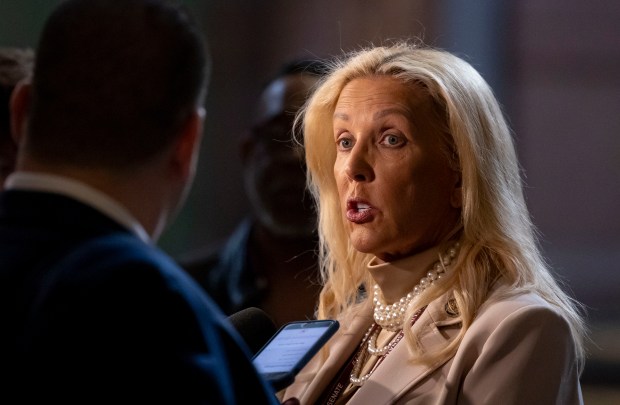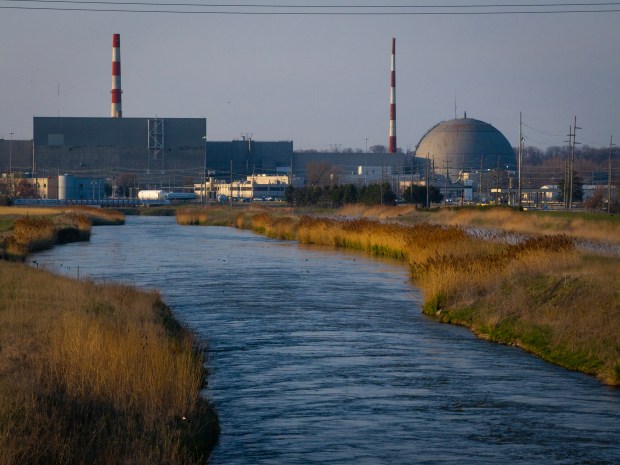SPRINGFIELD — As Illinois closes in on its deadline of being carbon-free by midcentury, even as demands for energy rise, legislators are looking to satisfy both needs through a strategy many so far have tried to avoid: allowing new, large-scale nuclear reactors to be built in the state.
The initiative wending through the General Assembly comes even though Gov. JB Pritzker vetoed and narrowed a similar plan two years ago when he set limits on the size of new nuclear power plants in Illinois. But the governor appeared open to taking a different tack when he said recently he’s willing to work with the bipartisan group of lawmakers backing the latest proposal that would permit the construction of nuclear reactors of any size.
“We’re looking forward to having a bill that comes to my desk that will allow us to expand the options for nuclear in the state of Illinois,” Pritzker said last week. “But it has to be done in the right way, and I think the legislature and my team are working together to make sure that that happens.”
Illinois has more nuclear reactors than any other state. But supporters of allowing new, large reactors to be constructed in Illinois, including labor and manufacturing advocates, argue that building more nuclear power plants is needed to help answer rising energy demands and the state’s ambitious clean energy goals, which call for retiring major traditional sources of power such as natural gas-fired energy plants by 2045.
The issue of broadly expanding nuclear power has historically ignited a divide between two core Democratic Party coalitions: labor unions and environmentalists. Unions like the idea because it will create more union jobs, but environmental groups think efforts to create new clean energy should go elsewhere.
What’s more, if Pritzker backs the idea of allowing the construction of nuclear reactors of any size in Illinois, that would be a significant backtrack from his previous positions.
In 2023, just before the General Assembly first attempted to lift the ban, the governor said he wanted “to make sure that we’re not just opening this up to nuclear everywhere or any type of nuclear.” Pritzker also told an audience at Harvard University’s Institute of Politics later that spring that lifting the ban would not include building any major new plants.
When Pritzker vetoed the 2023 effort, he cited that “vague definitions in the bill” would “open the door to proliferation of large-scale nuclear reactors that are so costly to build that they will cause exorbitant ratepayer-funded bailouts.” So when he approved the smaller measure that year ending a nearly four-decade moratorium on the construction of any nuclear plants in Illinois, he set limits on the size of those new plants and focused on small modular reactors, also known as SMRs, that work off new technology.
State Rep. Dave Vella, a Rockford Democrat who is helping spearhead the latest effort, said the political winds have changed, as have the state’s needs for more power.
“Two years ago, we were in different places,” Vella said. “I was there with (then-state Rep.) Lance Yednock when they ran the first bill, and the governor’s office was not on board for sure back then. I would say they have not been pushing back on me at all this year.”
Vella told the Tribune on Friday that he’s aiming to include key language in a legislative package being produced by a House energy working group. The bill could include guidelines allowing for new, large-scale nuclear reactors to be built in the state along with clean-energy initiatives, said state Rep. Ann Williams, a member of the working group.
“Dave had interesting energy ideas, and it’s a priority for him in his community to make sure we can advance clean energy sources, including nuclear, and so we thought it would make sense to include it,” Williams said. “Making sure that we have our energy needs met is a priority for all of us, and there’s a lot of things evolving in the conversation.”
Yet energy legislation in general has historically gotten bogged down in Springfield when lawmakers try to satisfy competing interests. That’s what happened in 2016 and 2021 when negotiations over major climate bills took multiple sessions to finalize. Vella said if that happens, he’ll push the measure later as an individual bill. The governor’s interest in the initiative could help move the bill forward, he added.
Williams is hopeful for a compromise by the end of May and said that since the passage of the state’s 2021 Climate and Equitable Jobs Act, state lawmakers have learned a lot about “how to put together a package that works for ratepayers, making sure we have enough power on the grid.”
Still, there is some opposition.
A spokesperson for the Illinois chapter of the Sierra Club, which is working on other major climate bills around battery storage, said the organization opposes allowing for the construction of large nuclear power plants in Illinois and questioned if nuclear energy is really “clean.”
“Nuclear power is, yes, it is low carbon, but it’s not totally clean,” said Jack Darin, director of the Illinois Sierra Club chapter. “There are real impacts associated with the full life cycle of nuclear power, from the mining of uranium to the disposal of waste in Illinois, which is already home to the most nuclear waste of any state in the country.”

If the legislation passes, Illinois would join a number of other states that have recently reversed similar bans as policymakers look to nuclear power as a reliable, carbon-free alternative to keep up with rising energy demands from data centers, advanced manufacturing, artificial intelligence and more.
Pritzker has welcomed this type of economic development as a priority in his second term, providing significant tax incentives for data centers building in the state.
“The future is electric, and we want to make sure that it’s as clean as possible, and we don’t want to revert back to coal,” said state Sen. Bill Cunningham, a Chicago Democrat who supports expanding nuclear power plant construction. “For data centers or other bigger projects … we need more power. We are in a really interesting time in nuclear power right now. It’s very much a boom.”
Advocates also include Mark Denzler, president and CEO of the Illinois Manufacturers’ Association. He said the the organization is worried about the state’s ability to keep up with this energy boom while also retiring major energy sources, which was called for with the 2021 climate and jobs act. Renewable energy sources aren’t reliable enough to sustainably support the state, Denzler said.
“Nuclear power operates 24 hours a day, seven days a week,” he said. “When you look at your intermittent sources such as wind and solar, the sun doesn’t always shine, the wind doesn’t always blow.”
The small modular reactors — which can begin being constructed on Jan. 1 according to the narrowed 2023 law — are not enough either, according to Denzler. Under the proposed legislation, both small modular reactors and larger reactors could be built in the state.
State Sen. Sue Rezin, a Republican from Morris, said loosening restrictions on building large reactors could attract new data center construction from large companies, creating new jobs and tax revenue.
“We just want to remove barriers and signal support that if a company chooses to build out nuclear power that Illinois should be considered as they’re considering where to invest,” Rezin said.
While the legislation might allow it, it’s unclear if there are companies actually looking to invest in the state’s nuclear power industry.

NuScale Power, the only company with a federally approved SMR design, pulled the plug on its first commercial project in 2023 in Utah due to a lack of financing. A spokesperson for Constellation Energy, which operates 11 nuclear reactors in Illinois, said Constellation “fully supports” the proposed legislation but has no plans to build new nuclear plants in Illinois. Instead, the company is focusing on extending the licenses of existing plants and investing in new equipment to increase their output, according to a statement.
Construction on nuclear reactors can also be “very expensive” to both the state and ratepayers, according to Darin, who says cost is the main reason the Illinois Sierra Club opposes the legislation.
“It’s by far the most expensive form of electricity,” Darin said. “It’s just unwise to move forward with new nuclear energy right now, especially when renewables have reached cost parity with other forms of generation.”
Darin is also worried about how tough federal oversight will be on nuclear plants. He noted President Donald Trump signed an executive order in February requiring independent regulatory agencies, including the U.S. Nuclear Regulatory Commission, to report efficiency and performance standards to ensure the agencies align with the president’s policies.
“This comes at a time when the Trump administration is gutting a lot of our nuclear safety bureaucracy so the framework that we’ve had to date that ensures there are watchdogs watching over these waste sites in our communities, we can’t count on them anymore,” Darin said.
Trump also issued an executive order last week pushing back on state policies to regulate energy use that could undermine Illinois’ transition to renewable energy sources under CEJA. Pritzker said Trump’s order interferes with states’ rights.
“They can supersede it if they want to pass a law. But you can’t just decide as the executive branch in the federal government to impede a state law,” the governor said.
While Vella is hopeful that restrictions are lifted, even if they are, nuclear power plants won’t be under construction overnight. It takes eight to 10 years to be approved by the NRC before companies can start construction on nuclear reactors, according to Rezin, and some argue the state’s energy needs do not demand urgency.
“My sense is that Illinois is not currently in a bind as far as power needs are concerned,” said Robert Rosner, a theoretical physicist and founding co-director of the Energy Policy Institute at the University of Chicago, adding that data center firms will likely want to build their own power sources.
And some opponents remember the partial nuclear meltdown in 1979 at Three Mile Island in Pennsylvania and worry expanding nuclear energy right now is rash.
David Kraft, co-founder of the Nuclear Energy Information Service, a nonprofit group opposed to nuclear power said the over 10,000 tons of nuclear waste in Illinois, according to NEIS, should be taken care of before more plants are built.
Indeed, nuclear waste was the motivation behind the 1987 ban on nuclear plant construction in Illinois.
“This is dangerous turf,” Kraft said. “Every nuclear reactor in the country, not just Illinois, has no place to dispose of its high-level radioactive waste, and nobody has bothered to really solve the disposal issue in an environmentally responsible way. That was the original purpose of the moratorium — you clean up your mess first before you make more of it.”




